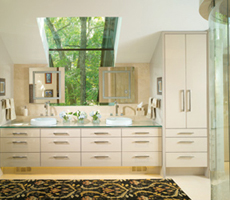 The concept of universal design continues to gain acclaim and prominence among architects, contractors and homeowners. With the growing demand for products that are accessible and functional; these products are becoming more attractive and appreciated.
The concept of universal design continues to gain acclaim and prominence among architects, contractors and homeowners. With the growing demand for products that are accessible and functional; these products are becoming more attractive and appreciated.
Ron Mace: architect, is credited with creating the concept on an international level. The formal definition of universal design stated by Mace is “the use of products, spaces and anesthetics to the greatest extent possible, regardless of status, ability or age.
The universal design concept changes the design paradigm of expecting people to adapt and function according to design. The new human-centered design employs products and design to support lifestyle and circumstances as we currently live. Additionally it must adhere to differences in human factors while utilizing appealing aesthetics.
Universal design concept targets the entire population, considering that changes occur over the life of the home and its occupants. Conversely, aging-in-place refers to environmental modifications that support the aging process as it advances.
The baby boomers finding: aging-in-place more desirable and the drive to reduce environmental impacts have both contributed to the growth of universal design. When a home’s design utilizes Universal design it reduces or eliminates the need of modifications later in life. This makes universal design products not only a smart choice for seniors but for children as well.
Home appliance and plumbing manufacturers continue to produce more products to enhance safer, simpler and more comfort while retaining beauty.
Universal design – Bathroom
One of most critical spaces in the home for safety is the bathroom. There are countless products from shower to lighting to keep the bathroom safer for all occupants.
Zero-threshold shower bases
- European style with a seamless and beautiful shower.
- Flush with the floor and often feature a trench drain to contain water in the shower area.
- Easy access for foot and wheelchair traffic.
- A slip-resistant, textured floor to help prevent shower accidents .
Grab bars
- Tub or shower area
- Next to the toilet provide safety and support for anyone.
Night lighting
- Easier navigation without assistance at night.
- Increased room color contrasts to offset decreased visibility.
Tub
- Ledge or seating on tub edge adds improves ease in maneuvering in and out of the tub.
- Providing an area for caregivers to sit. This feature can enhance the bathing experience for young children who need to be supervised or an older adult who requires a more accessible bathing solution
In keeping the universal design concepts in mind, manufacturers are producing more design options and flexibility to coordinate the aesthetics with faucet and share textures and as decorative or functional components.
Universal design – Kitchen
Kitchen lighting, accessories and appliances have seen incredible design improvements to make them more intuitive, easier and safer to use.
Dishwashers and refrigerators can now be built into drawer spaces for easier access. In addition, induction countertops are more energy efficient and offers improved safety compared to conventional stoves. Induction stove surface remains neutral during cooking and the cooktop is shallow so it may create space for wheelchair users.
Counters
- Empty space under countertops around sinks or cooking areas is great seated access and flexibility.
- Lower countertops and sinks give easier access to children and wheelchair users.
- Roll-out shelves or drawers make it easier to see and reach items stored in lower cabinets.
- Pull-out counter underneath a built-in single wall oven makes transfer of hot dishes or pans from the oven easier.
Hands-free or touch-activated faucets promotes easier to use for children individuals with arthritis or compromised strength. To conserve water, many have a automatic shut-off.
With universal design; beauty, safety, convenience and independence can all be improved for all household members.
